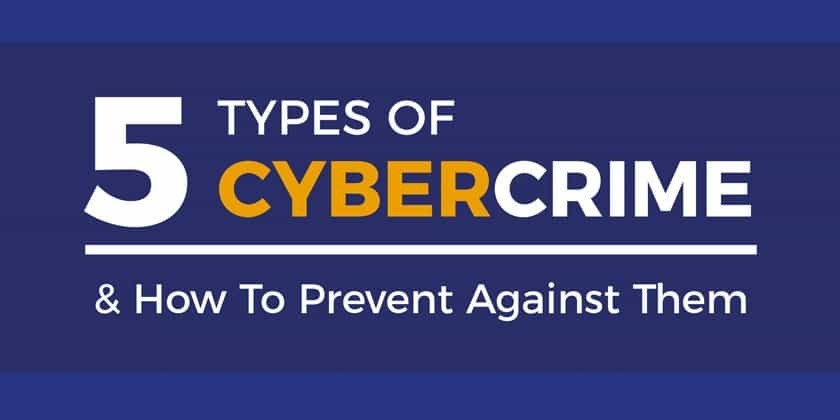With the invention of new technology and the growing reliance on the internet, cyber crimes have emerged as one of the primary forms of threat to people, businesses and economies around the world. As we depend more and more on the cyberspace for activities like communication, banking, trading, or even recreation, there is no doubt that unemployed ‘hackers’ are always devising newer methods to take advantage of the chinks in the armors of security systems. In order to keep information safe and confidential, it is important to know what cyber crimes exist and how to counterattack them.
This article focuses on 5 prevalent cyber crimes along with feasible prevention methods for each.
1. Phishing
What is it:
Phishing is a common type of fraud that involves an attacker masquerading as a credible institution that contacts the user via email and attempts to request personal information from them. Breaking through their defenses involves tricks like posing as a bank request e-mails with the intention of collecting sensitive personal information such as passwords, and credit card details.
The attack can come in two forms; general and targeted attacks, also called general phishing or spear phishing respectively. In fact, most phishing messages masquerading as bank notifications to unsuspecting customers are usually spear phishing.
How to Avoid It:
- Always Confirm The Source: Avoid clicking on links, or downloading files from emails claiming suspicious titles.
- Check The Address: Always scrutinize web addresses especially if the link has been shared.
- Employ Filtering Mechanisms: Use adjustable spam filters to catch attempts littering your inbox with phishing.
- Teach Yourself and Others: Having awareness is crucial. Teach yourself how to identify phishing attempts and give lessons to your employees or loved ones.
- Multi-Factor Authentication (MFA): Even if your password gets compromised, unauthorized accessed can still be denied via MFA.
2. Ransomwar
What It Is:
Ransomware is a malicious type of software that encrypts a victim’s data and demands payment – usually in the form of cryptocurrency – to unlock it. It has the potential to severely restrict access to essential files for hospitals, schools, businesses, and individuals.
Ransomware attacks on the colonial infrastructure or healthcare systems are just some of the high-profile examples that highlight the menace of cybercrime.
How to Prevent It:
- Regular Backups: Make sure to save the redundant copies of crucial information on a separate device that isn’t connected to the internet. This allows easy recovery without a ransom.
- Update Software Regularly: Regular updates tend to fix existing security loopholes that leave openings for exploitation.
- Avoid Suspicious Downloads: Avoid downloading software or opening email attachments from untrusted sources.
- Use Antivirus and Anti-Malware Tools: Invest in high-quality security software capable of stopping ransomware before it can inflict damage.
- Network Segmentation: Restrict remote access between systems for Organizations to limit the lateral movement of ransomware throughout the network.
3. Identity Theft
What It Is:
A person’s identity may be stolen and impersonated by hackers in the form of stealing private information such as the personal addresses, banking accounts, social security number, identification card, among other sensitive data. This crime is usually conducted for monetary gain or other heinous intended motives. In such cases, victims are frequently oblivious until the debt collection calls pour in or applying for new lines of credit leads to rejections due to unpaid balances.
How to Prevent It:
- Safeguarding of Private Information:
Social media confidentiality is best protected through restriction from oversharing and limited visibility using privacy settings. - Account Statements Monitoring:
Any irregularities in credit card or bank accounts’ statements should be flagged and investigated. - Account Protection:
Use unique passwords that further buy time like the use of upper case, lower case letters, numbers, and symbols. No two platforms should have shared passwords. - Document Disposal:
Utility bills, tax forms and bank statements each need to be disposed of in a manner that renders it impossible to be reproduced.
These types of services have the ability to notify when sensitive personal documents such as social security numbers or mileage would be engaged in any bizarre and malignant behaviors that would need such alerts.
4. Cyberstalking and Online Harassment
What It Is:
Cyberstalking includes repeated and persistent harassment, intimidation, threats and unwarranted attention through emails, text messages or other forms of social media platforms. This is a dangerous criminal offense which may result to serious emotional suffering, anxiety, and posing life threatening risks.
A major category of online harassment has grown against women, public figures, and people from the minorities such as doxxing (the release of private documents), and trolling.
Protect Yourself:
- Keep Personal Information Private: Make sure you have the privacy settings on social media platforms set to the highest level. Do not publicly share sensitive personal information.
- Report and Block Abusers: Users can be blocked on most social platforms and abusive behavior can be reported.
- Document the Abuse: Store messages, screenshots, and other evidence. This could be important in the event that legal action must be undertaken.
- Use Anonymous Usernames: Do not use names in informal settings which can identify you.
- Contact Authorities When Needed: If there is a tangible threat, local law enforcement or counsel should be engaged.
5. Financial Fraud and Online Scams
What It Is:
This is used to described broad categories such as abuse related to credit cards and online shopping, fraudulent investment schemes like Ponzi schemes, and romantic scams. Oftentimes victims are deceived into remitting money or disclose sensitive financial information to scammers masquerading as genuine businesses or individuals.
Such frauds are committed through online marketplaces, dating sites, and even employment websites.
How to Prevent It:
- Always Confirm the Seller and Website: Do not purchase from unfamiliar sellers found on lesser-known platforms.
- Protect Payment Methods: Do not directly wire money or send cash. Instead, send using credit cards or safeguarded payment processors such as PayPal.
- Be Careful of Deals That Look Too Enticing: Everything comes with a price, might as well double check if a particular offer sounds too good to be true.
- Look Out for Communication Blunders: Scammers mostly use poor grammar alongside vague sentences which lack detail, so they mislead people into buying products.
- Activate Alerts: Set alerts for banking activity or any unusual transactions linked to your accounts.
Conclusion
Cybercrime is one of the fastest evolving fields these days, and unfortunately, everyone, whether an individual or an organization, is increasingly targeted. The good part is many forms of cyber crimes can be avoided through proper education and maintaining a high level of safety online.
Key Takeaways:
- Be constantly informed with the latest news related to modern-day cyber crimes.
- Basic hygiene when it comes to cyber security should be observed, these include employing strong passwords, regularly updating softwares, and creating backups.
- Treat unexpected messages and offers with a lot of skepticism.
- If you suspect any form of cyber crime, take swift action whether that’s suing, freezing your accounts, or reporting to authorities.
Taking the time to understand the different forms of cyber crimes and ways to go against them makes you and people around you more empowered to use technology safely.

